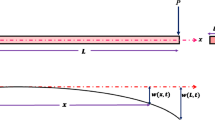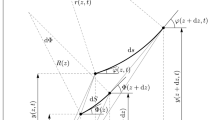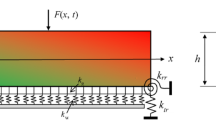Abstract
Subjected to high level forcing, flexible and curved beams exhibit pronounced geometrical nonlinearities. In particular, intrinsic nonlinearities of cantilevers are different from their counterparts with end-constrained boundaries and the combination of the enhanced nonlinear-inertia effects with initial curvature creates harsh demand on the modeling, numerical simulation and understanding of associated physical phenomena. This paper investigates the salient nonlinear features in a curved cantilever beam, with particular attention paid to the inertia-induced effects through both linear and nonlinear analyses. An inextensible condensation model, with the consideration of the initial curvature, is proposed based on a geometrically exact model for an Euler–Bernoulli cantilever beam. The free boundary of the cantilever gives rise to more significant longitudinal motion, which increases the inertia effects in the beam vibration which is in turn enhanced by the initial curvature. Specific techniques are proposed to numerically implement the developed model with increased accuracy and robustness. Numerical simulations are then conducted to validate the proposed model through comparisons with the finite element method, examine the assumptions underpinning the model and explore the salient physical features, in particular the inertia-induced effects in both linear and nonlinear cases. Results show a decrease in the natural frequencies due to the initial curvature effect, a transition of the first mode from hardening to softening caused by enhanced curvature-induced inertia effect, and a pronounced asymmetry of the higher order modes with respect to frequencies.











Similar content being viewed by others
Data availability
The datasets generated during and/or analyzed during the current study are available from the corresponding author on reasonable request.
References
Pai, P.F., Nayfeh, A.H.: A fully nonlinear theory of curved and twisted composite rotor blades accounting for warpings and three-dimensional stress effects. Int. J. Solids Struct. 31(9), 1309–1340 (1994)
Nayfeh, A.H., Lacarbonara, W., Chin, C.-M.: Nonlinear normal modes of buckled beams: three-to-one and one-to-one internal resonances. Nonlinear Dyn. 18(3), 253–273 (1999)
Yu, A.M., Yang, J.W., Nie, G.H., Yang, X.G.: An improved model for naturally curved and twisted composite beams with closed thin-walled sections. Compos. Struct. 93(9), 2322–2329 (2011)
Ghayesh, M.H., Amabili, M.: Coupled longitudinal-transverse behaviour of a geometrically imperfect microbeam. Compos. B Eng. 60, 371–377 (2014)
Yi, Z., Stanciulescu, I.: Nonlinear normal modes of a shallow arch with elastic constraints for two-to-one internal resonances. Nonlinear Dyn. 83(3), 1577–1600 (2016)
Qiao, W., Guo, T., Kang, H., Zhao, Y.: Softening–hardening transition in nonlinear structures with an initial curvature: a refined asymptotic analysis. Nonlinear Dyn. 107(1), 357–374 (2022)
Touzé, C., Vizzaccaro, A., Thomas, O.: Model order reduction methods for geometrically nonlinear structures: a review of nonlinear techniques. Nonlinear Dyn. 105(2), 1141–1190 (2021)
Lacarbonara, W.: Nonlinear structural mechanics: theory, dynamical phenomena and modeling. Springer (2013)
Nayfeh, A.H., Pai, P.F.: Linear and nonlinear structural mechanics. Wiley (2008)
Ding, H., Chen, L.-Q.: Nonlinear vibration of a slightly curved beam with quasi-zero-stiffness isolators. Nonlinear Dyn. 95(3), 2367–2382 (2019)
Kármán, T.V.: Festigkeitsprobleme im Maschinenbau. In: Klein, F., Müller, C. (eds.) Mechanik, pp. 311–385. Vieweg+Teubner Verlag, Wiesbaden (1907)
Lagnese, J.E.: Boundary stabilization of thin plates. SIAM (1989)
Lagnese, J.E., Leugering, G.: Uniform stabilization of a nonlinear beam by nonlinear boundary feedback. J. Differ. Equ. 91(2), 355–388 (1991)
Koch, H., Lasiecka, I.: Hadamard Well-posedness of Weak Solutions in Nonlinear Dynamic Elasticity-full von Karman Systems. In: Lorenzi, A., Ruf, B. (eds.) Evolution Equations, pp. 197–216. Semigroups and Functional Analysis. In Memory of Brunello Terreni, Birkhäuser Basel, Basel (2002)
Alijani, F., Amabili, M.: Non-linear vibrations of shells: A literature review from, 2003 to 2013. Int. J. Non-Linear Mech. 58, 233–257 (2014)
Nayfeh, A.H., Mook, D.T.: Nonlinear oscillations. Wiley, UK (2008)
Amabili, M.: Nonlinear vibrations and stability of shells and plates. Cambridge University Press (2008)
Bhashyam, G.R., Prathap, G.: Galerkin finite element method for non-linear beam vibrations. J. Sound Vib. 72(2), 191–203 (1980)
Lee, J., Kerschen, G., Detroux, T.: Harmonic balance computation of the nonlinear frequency response of a thin plate, (2017)
Amabili, M.: Theory and experiments for large-amplitude vibrations of rectangular plates with geometric imperfections. J. Sound Vib. 291(3), 539–565 (2006)
Touzé, C., Camier, C., Favraud, G., Thomas, O.: Effect of imperfections and damping on the type of nonlinearity of circular plates and shallow spherical shells. Math. Probl. Eng. 2008, 678307 (2008)
Lacarbonara, W., Arafat, H.N., Nayfeh, A.H.: Non-linear interactions in imperfect beams at veering. Int. J. Non-Linear Mech. 40(7), 987–1003 (2005)
Yi, Z., Wang, L., Kang, H., Tu, G.: Modal interaction activations and nonlinear dynamic response of shallow arch with both ends vertically elastically constrained for two-to-one internal resonance. J. Sound Vib. 333(21), 5511–5524 (2014)
Bauchau, O.A., Hong, C.H.: Large displacement analysis of naturally curved and twisted composite beams. AIAA J. 25(11), 1469–1475 (1987)
Ibrahimbegović, A.: On finite element implementation of geometrically nonlinear Reissner’s beam theory: three-dimensional curved beam elements. Comput. Methods Appl. Mech. Eng. 122(1), 11–26 (1995)
Crespo da Silva, M.R.M., Glynn, C.C.: Nonlinear flexural-flexural-torsional dynamics of inextensional beams. I. Equations of motion. J. Struct. Mech. 6(4), 437–448 (1978)
Culver, D., McHugh, K., Dowell, E.: An assessment and extension of geometrically nonlinear beam theories. Mech. Syst. Signal Process. 134, 106340 (2019)
Nayfeh, A.H., Pai, P.F.: Non-linear non-planar parametric responses of an inextensional beam. Int. J. Non-Linear Mech. 24(2), 139–158 (1989)
Thomas, O., Sénéchal, A., Deü, J.F.: Hardening/softening behavior and reduced order modeling of nonlinear vibrations of rotating cantilever beams. Nonlinear Dyn. 86(2), 1293–1318 (2016)
McHugh, K., Dowell, E.: Nonlinear responses of inextensible cantilever and free-free beams undergoing large deflections. J. Appl. Mech. 85(5), 051008 (2018)
Dowell, E., McHugh, K.: Equations of motion for an inextensible beam undergoing large deflections. J. Appl. Mech. (2016). https://doi.org/10.1115/1.4032795
Anderson, T.J., Nayfeh, A.H., Balachandran, B.: Experimental verification of the importance of the nonlinear curvature in the response of a cantilever beam. J. Vib. Acoust. 118(1), 21–27 (1996)
Kumar, A.: Effect of approximation of curvature/inertia on the nonlinear vibrations of cantilever beam. Structures 26, 737–744 (2020)
Farokhi, H., Xia, Y., Erturk, A.: Experimentally validated geometrically exact model for extreme nonlinear motions of cantilevers. Nonlinear Dyn. 107(1), 457–475 (2022)
Amabili, M., Ferrari, G., Ghayesh, M.H., Hameury, C., Hena Zamal, H.: Nonlinear vibrations and viscoelasticity of a self-healing composite cantilever beam: Theory and experiments. Compos. Struct. 294, 115741 (2022)
Semler, C., Li, G.X., Paϊdoussis, M.P.: The non-linear equations of motion of pipes conveying fluid. J. Sound Vib. 169(5), 577–599 (1994)
Paidoussis, M.P.: Fluid-structure interactions: slender structures and axial flow. Academic press (1998)
Deliyianni, M., McHugh, K., Webster, J.T., Dowell, E.: Dynamic equations of motion for inextensible beams and plates. Arch. Appl. Mech. 92(6), 1929–1952 (2022)
McHugh, K.A., Dowell, E.H.: Nonlinear response of an inextensible, cantilevered beam subjected to a nonconservative follower force. J. Comput. Nonlinear Dyn. 14(3), (2019)
Malatkar, P.: Nonlinear vibrations of cantilever beams and plates. Virginia Polytechnic Institute and State University (2003)
Deliyianni, M., Webster, J.T.: Theory of solutions for an inextensible cantilever. Appl. Math. Optim. 84(2), 1345–1399 (2021)
Deliyianni, M., Gudibanda, V., Howell, J., Webster, J.T.: Large deflections of inextensible cantilevers: modeling, theory, and simulation. Math. Model. Nat. Phenom. 15, 44 (2020)
Amabili, M., Paı¨doussis, M.P.: Review of studies on geometrically nonlinear vibrations and dynamics of circular cylindrical shells and panels, with and without fluid-structure interaction. Appl. Mech. Rev. 56(4), 349–381 (2003)
Pan, K.-Q., Liu, J.-Y.: Geometric nonlinear dynamic analysis of curved beams using curved beam element. Acta. Mech. Sin. 27(6), 1023–1033 (2011)
Liu, J., Hong, J., Cui, L.: An exact nonlinear hybrid-coordinate formulation for flexible multibody systems. Acta. Mech. Sin. 23(6), 699–706 (2007)
Tang, S., Sweetman, B.: A geometrically-exact momentum-based non-linear theory applicable to beams in non-inertial frames. Int. J. Non-Linear Mech. 113, 158–170 (2019)
Zulli, D., Alaggio, R., Benedettini, F.: Non-linear dynamics of curved beams Part 1: formulation. Int. J. Non-Linear Mech. 44(6), 623–629 (2009)
Zulli, D., Alaggio, R., Benedettini, F.: Non-linear dynamics of curved beams. Part 2, numerical analysis and experiments. Int. J. Non-Linear Mech. 44(6), 630–643 (2009)
Shen, Y., Vizzaccaro, A., Kesmia, N., Yu, T., Salles, L., Thomas, O., Touzé, C.: Comparison of reduction methods for finite element geometrically nonlinear beam structures. Vibration 4(1), 175–204 (2021)
Cochelin, B., Vergez, C.: A high order purely frequency-based harmonic balance formulation for continuation of periodic solutions. J. Sound Vib. 324(1), 243–262 (2009)
Woiwode, L., Balaji, N.N., Kappauf, J., Tubita, F., Guillot, L., Vergez, C., Cochelin, B., Grolet, A., Krack, M.: Comparison of two algorithms for harmonic balance and path continuation. Mech. Syst. Signal Process. 136, 106503 (2020)
Detroux, T., Renson, L., Masset, L., Kerschen, G.: The harmonic balance method for bifurcation analysis of large-scale nonlinear mechanical systems. Comput. Methods Appl. Mech. Eng. 296, 18–38 (2015)
Detroux, T., Noël, J.-P., Virgin, L.N., Kerschen, G.: Experimental study of isolas in nonlinear systems featuring modal interactions. PLoS ONE 13(3), e0194452 (2018)
Chung, J., Hulbert, G.M.: A time integration algorithm for structural dynamics with improved numerical dissipation: the generalized-α method. J. Appl. Mech. 60(2), 371–375 (1993). https://doi.org/10.1115/1.2900803
Pai, P.F., Anderson, T.J., Wheater, E.A.: Large-deformation tests and total-Lagrangian finite-element analyses of flexible beams. Int. J. Solids Struct. 37(21), 2951–2980 (2000)
Pai, P.F.: Problems in geometrically exact modeling of highly flexible beams. Thin-Walled Struct. 76, 65–76 (2014)
Webb, J.: Imposing linear constraints in finite-element analysis. Commun. Appl. Numer. Methods 6(6), 471–475 (1990)
Cameron, T.M., Griffin, J.H.: An alternating frequency/time domain method for calculating the steady-state response of nonlinear dynamic systems. J. Appl. Mech. 56(1), 149–154 (1989)
Tang, D., Zhao, M., Dowell, E.H.: Inextensible beam and plate theory: computational analysis and comparison with experiment. J. Appl. Mech. (2014). https://doi.org/10.1115/1.4026800
Peeters, M., Viguié, R., Sérandour, G., Kerschen, G., Golinval, J.C.: Nonlinear normal modes, Part II: toward a practical computation using numerical continuation techniques. Mech. Syst. Signal Process. 23(1), 195–216 (2009)
Coddington, E.A., Levinson, N.: Theory of ordinary differential equations. Tata McGraw-Hill Education (1955)
Acknowledgements
Authors thank the Research Grant Council of the Hong Kong SAR (PolyU 152023/20E) for financial support.
Funding
The authors have not additional funding.
Author information
Authors and Affiliations
Corresponding author
Ethics declarations
Conflict of interest
The authors declare that they have no conflict of interest.
Additional information
Publisher's Note
Springer Nature remains neutral with regard to jurisdictional claims in published maps and institutional affiliations.
Appendices
Appendix 1
The generalized-α method
The generalized-α method is applied to offer intuitive time history of the system responses. In the main text, Eq. (19) requires the treatment of different system response terms, especially displacement x, as well as its derivatives representing velocity \({\dot{\mathbf{x}}}\) and acceleration \({\ddot{\mathbf{x}}}\). The interrelation among them can be cast into the following general form [54]:
The governing equation of motion, Eq. (19), is built on semi-point scheme in the time discretization. The semi-point values of these quantities write
A residual vector is formulated from Eq. (19) as
Discretized version of the above equation in terms of \(({\mathbf{x}}_{{i + 1 - \alpha_{f} }} ,{\dot{\mathbf{x}}}_{{i + 1 - \alpha_{f} }} ,{\ddot{\mathbf{x}}}_{{i + 1 - \alpha_{m} }} )\) writes
Let us denote \(({\mathbf{x}}_{{i + 1 - \alpha_{f} }}^{k} ,{\dot{\mathbf{x}}}_{{i + 1 - \alpha_{f} }}^{k} ,{\ddot{\mathbf{x}}}_{{i + 1 - \alpha_{m} }}^{k} )\) as the approximate value of \(({\mathbf{x}}_{{i + 1 - \alpha_{f} }} ,{\dot{\mathbf{x}}}_{{i + 1 - \alpha_{f} }} ,{\ddot{\mathbf{x}}}_{{i + 1 - \alpha_{m} }} )\) resulting from the iteration k. In the vicinity of the prediction value, the residual equation can be replaced with sufficient accuracy through the following linear expression:
in which the Jacobian (also called iteration) matrix writes:
whose expression is detailed as
The integration relationship, Eq.(46), can be written as
Combining Eqs. (52) and (53) yields the expression of the iteration matrix as:
The nonlinear equation (50) is then solved using an iteration scheme using Newton–Raphson method. Substituting Eqs. (46 and 47) into Eq. (50) gives
with
The velocity and acceleration are found from
When \(k = 0\), the initial prediction to initialize the process is \({\ddot{\mathbf{x}}}_{i + 1}^{0} = {\ddot{\mathbf{x}}}_{i}\) as the first-order approximation, which would need more correction steps.
To simplify the process and reduce the computation burden, an alternative prediction formulation with third-order precision, i.e.,\({\ddot{\mathbf{x}}}_{i + 1}^{0} = 4{\ddot{\mathbf{x}}}_{i} - 6{\ddot{\mathbf{x}}}_{i - 1} + 4{\ddot{\mathbf{x}}}_{i - 2} - {\ddot{\mathbf{x}}}_{i - 3}\), is proposed by using the four latest points. Stepwise correction continues until \(||{\mathbf{r}}({\mathbf{x}}_{i + 1}^{k} )|| \le \varepsilon\), where ε is a predefined tolerance value.
The above calculation scheme is combined with the generalized-α method [54]. The parameters are chosen as follows
The dissipation parameter \(\rho_{\infty }\) is set to 0.8 in the present study.
Appendix 2
Efficiency and robustness enhanced by OS technique
The OS technique discussed in Sect. 3.2 is expected to improve the efficiency and the robustness of the generalized-α method by separating a full complex problem into several sub-problems. To demonstrate this, the generalized-α methods with and without the OS technique are compared using a beam vibration problem.
Examine the straight cantilever beam (used in Sect. 4) excited by a harmonic force at its free end. The excitation force has an amplitude 0.5 N at 3.85 Hz, which is arbitrarily chosen around the first natural frequency of the beam. The computation duration is 70 s, which is long enough to get stable response in the system. The sampling frequency is \(f_{s} = 400\;{\text{Hz}}\). Figure
12a illustrates the overall time response signals obtained by using the two methods. The two curves coincide completely during the entire time duration, as better shown in the close-up view (Fig. 12b). The residual values (as defined by Eq. (56) in Appendix 1) are calculated for both methods and shown in Fig.
13a. It follows that OS technique yields very small residuals, which are smaller than the ones without OS for nearly every single time point, demonstrating the accuracy of the proposed OS technique. Figure 13b shows the minimum iteration number required to achieve converged result with a residual value capped at \(10^{ - 6}\). It can be seen that, by embedding the OS technique into the generalized-α method, it takes only one iteration to reach converged result, while more iterations are required without OS technique. This happens even within the stable region. Moreover, it was also noticed that generalized-α method without OS technique may not always yield converged solution for some frequencies, while the one with OS technique always does. The above comparison shows the high efficiency and the robustness of the generalized-α method after embedding the proposed OS technique.
Rights and permissions
Springer Nature or its licensor (e.g. a society or other partner) holds exclusive rights to this article under a publishing agreement with the author(s) or other rightsholder(s); author self-archiving of the accepted manuscript version of this article is solely governed by the terms of such publishing agreement and applicable law.
About this article
Cite this article
Sun, X., Kerschen, G. & Cheng, L. Geometrical nonlinearities in a curved cantilever beam: a condensation model and inertia-induced nonlinear features. Nonlinear Dyn 111, 6533–6556 (2023). https://doi.org/10.1007/s11071-022-08162-3
Received:
Accepted:
Published:
Issue Date:
DOI: https://doi.org/10.1007/s11071-022-08162-3






